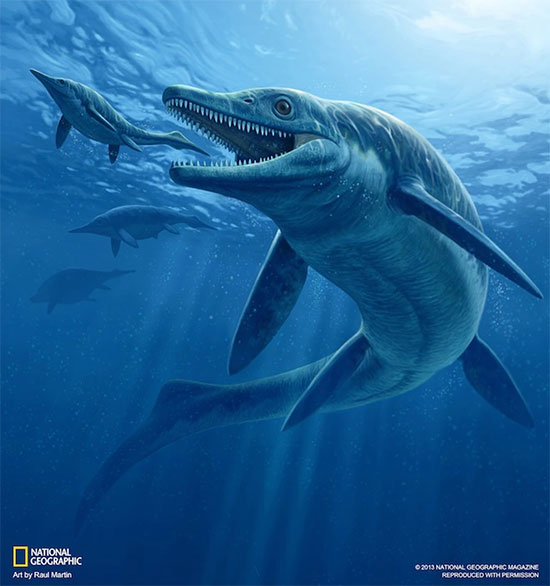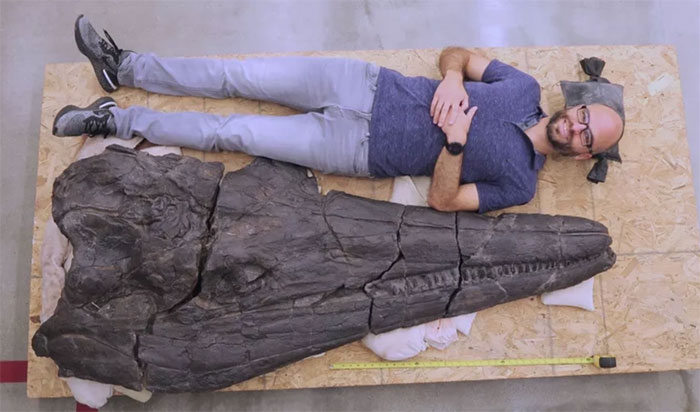Giant 17-meter-long sea monster reveals the secret of 'miracle evolution'
An unbelievably large early dinosaur sea monster has revealed evolutionary secrets.
In ancient times, many creatures on land and in the water chose to evolve larger and larger sizes to avoid becoming "prey", as well as to survive more effectively with an abundant food source.

Image depicting sea monsters ichthyosaurs.
New research from archaeologists confirms that fish-like marine reptiles have grown to enormous sizes in a span of just 2.5 million years. By comparison, it took whales about 90 percent of their 55-million-year history to reach the enormous size that ichthyosaurs (a subfamily of marine reptiles) did.
"Ichthyosaurs evolved much faster than whales, at a time when the world was recovering from a devastating extinction at the end of the Permian," said Lars Schmitz, a senior researcher at Scripps University.
"It's a good glimmer of hope and a sign of life's resilience - if the environmental conditions are right, evolution can happen very quickly and life can recover."
Researchers first noticed the fossil of an ancient ichthyosaur discovered in 1998, in the Augusta Mountains, northwestern Nevada (USA).
But it was not until 2015, with the help of specialized helicopters, that they were able to excavate all remaining fossils including skulls, shoulders. and transport them to the Natural History Museum. Los Angeles, where it was analyzed.

The skull size of the ancient reptile C. youngorum compared to an adult.
According to a study published December 23 in the journal Science, the team named the new species Cymbospondylus youngorum (C. youngorum).
They belong to the subfamily of large jawed marine reptiles, which lived 247 million years ago during the Triassic period, with elongated bodies and modified limbs and fins and a tail.
There were many giant animals that lived in the age of dinosaurs, but C. youngorum stands out for a number of reasons. For example, they are a rare large creature, surviving about 5 million years after the mass extinction event 252 million years ago at the end of the Permian period, which killed about 90% of all species on Earth. .
According to studies, it took about 9 million years for life on Earth to recover from the above extinction event. However, somehow, the species C. youngorum survived and thrived.

C. youngorum miraculously survived and thrived after the extinction.
One hypothesis is that there was an explosion of diversification in marine mollusks known as ammonoids within 1 million to 3 million years after the mass extinction event.
It was these species that became the food source for C. youngorum, as well as modern whales. However, their ways of evolution and development are different.
"The new fossil shows the dramatic evolution of enormous size in ichthyosaurs. In contrast, whales appear to have followed a different route to their present size, but not as quickly," Schmitz said. evaluate.
- Headless skeleton of 6 meter long sea monster
- The 4.2-meter monster crocodile traps Australian hunters
- Mysterious skinhead monster in Japanese legend
- Surely the giant sea monster swam under the water, marveling at the truth
- A half-meter-long corpse made the British confused
- Loch Ness monster secret secret code
- Display giant ink
- Detecting giant sea monster corpses
- Catch the 'monster' spider of 20cm long in Hoa Binh
- Ability to exist a 200 meter high ice wall under physical view
- Loch Ness Monster can be a giant eel
- A half-meter mouse may bite the coconut shell
 Discovered an ancient centipede fossil 99 million years old
Discovered an ancient centipede fossil 99 million years old Discovered bat-like dinosaurs in China
Discovered bat-like dinosaurs in China Discovered a 200-year-old bronze cannon of the coast
Discovered a 200-year-old bronze cannon of the coast Discover 305 million-year-old spider fossils
Discover 305 million-year-old spider fossils